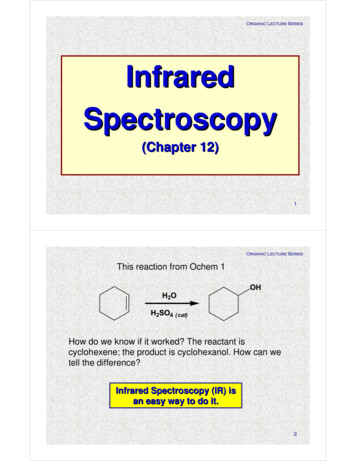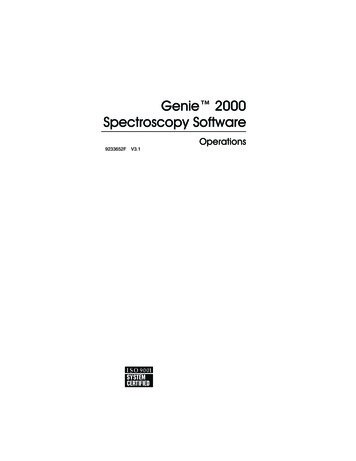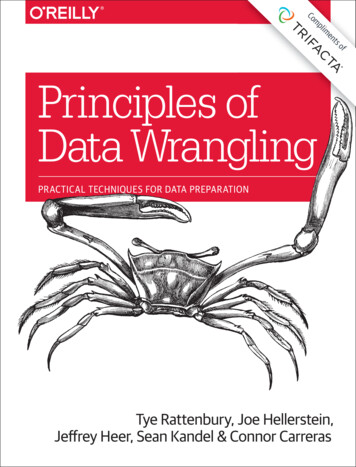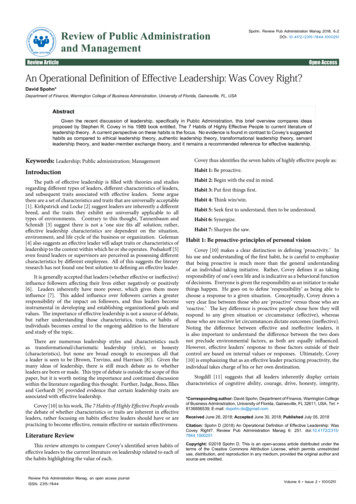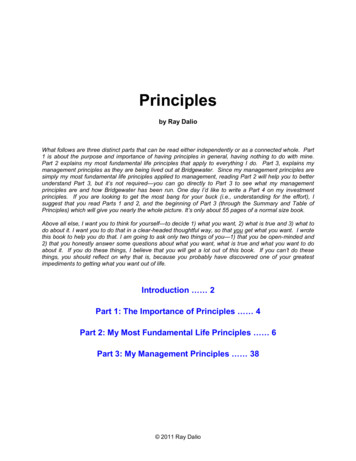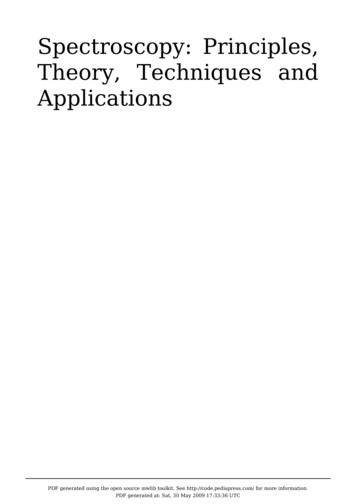
Transcription
Spectroscopy: Principles,Theory, Techniques andApplicationsPDF generated using the open source mwlib toolkit. See http://code.pediapress.com/ for more information.PDF generated at: Sat, 30 May 2009 17:33:36 UTC
SpectroscopySpectroscopy-An IntroductionSpectroscopySpectroscopy was originally thestudy of the interaction betweenradiation and matter as a ectroscopyreferred to the use of visible lightdispersedaccordingtoitswavelength, e.g. by a prism. Laterthe concept was expanded greatlyto comprise any measurement of aquantity as function of eitherwavelength or frequency. Thus itAnimation of the dispersion of light as it travels through aalso can refer to a response to antriangular prismalternatingfieldorvaryingfrequency (ν). A further extensionof the scope of the definition added energy (E) as a variable, once the very closerelationship E hν for photons was realized (h is the Planck constant). A plot of theresponse as a function of wavelength—or more commonly frequency—is referred to as aspectrum; see also spectral linewidth.Spectrometry is the spectroscopic technique used to assess the concentration or amountof a given species. In those cases, the instrument that performs such measurements is aspectrometer or spectrograph.Spectroscopy/spectrometry is often used in physical and analytical chemistry for theidentification of substances through the spectrum emitted from or absorbed by them.Spectroscopy/spectrometry is also heavily used in astronomy and remote sensing. Mostlarge telescopes have spectrometers, which are used either to measure the chemicalcomposition and physical properties of astronomical objects or to measure their velocitiesfrom the Doppler shift of their spectral lines.2
SpectroscopyClassification of methodsNature of excitationmeasuredThe type of spectroscopy dependson the physical quantity measured.Normally, the quantity that ismeasured is an intensity, either ofenergy absorbed or produced. Electromagnetic spectroscopyinvolves interactions of matterwith electromagnetic radiation,such as light. Electron spectroscopyExtremely high resolution spectrum of the Sun showinginvolves interactions withthousands of elemental absorption lines (Fraunhofer lines)electron beams. Augerspectroscopy involves inducing the Auger effect with an electron beam. In this case themeasurement typically involves the kinetic energy of the electron as variable. Mass spectrometry involves the interaction of charged species with magnetic and/orelectric fields, giving rise to a mass spectrum. The term "mass spectroscopy" isdeprecated, for the technique is primarily a form of measurement, though it doesproduce a spectrum for observation. This spectrum has the mass m as variable, but themeasurement is essentially one of the kinetic energy of the particle. Acoustic spectroscopy involves the frequency of sound. Dielectric spectroscopy involves the frequency of an external electrical field Mechanical spectroscopy involves the frequency of an external mechanical stress, e.g. atorsion applied to a piece of material.Measurement processMost spectroscopic methods are differentiated as either atomic or molecular based onwhether or not they apply to atoms or molecules. Along with that distinction, they can beclassified on the nature of their interaction: Absorption spectroscopy uses the range of the electromagnetic spectra in which asubstance absorbs. This includes atomic absorption spectroscopy and variousmolecular techniques, such as infrared spectroscopy in that region and nuclear magneticresonance (NMR) spectroscopy in the radio region. Emission spectroscopy uses the range of electromagnetic spectra in which a substanceradiates (emits). The substance first must absorb energy. This energy can be from avariety of sources, which determines the name of the subsequent emission, likeluminescence. Molecular luminescence techniques include spectrofluorimetry. Scattering spectroscopy measures the amount of light that a substance scatters atcertain wavelengths, incident angles, and polarization angles. The scattering process ismuch faster than the absorption/emission process. One of the most useful applications oflight scattering spectroscopy is Raman spectroscopy.3
Spectroscopy4Common typesAbsorptionAbsorption spectroscopy is a technique in which the power of a beam of light measuredbefore and after interaction with a sample is compared. When performed with tunablediode laser, it is often referred to as Tunable diode laser absorption spectroscopy (TDLAS).It is also often combined with a modulation technique, most often wavelength modulationspectrometry (WMS) and occasionally frequency modulation spectrometry (FMS) in orderto reduce the noise in the system.FluorescenceFluorescence spectroscopy useshigher energy photons to excite asample, which will then emit lowerenergy photons. This techniquehas become popular for itsbiochemicalandmedicalapplications, and can be used forconfocal microscopy, fluorescenceresonance energy transfer, andfluorescence lifetime imaging.X-rayWhenX-raysofsufficientSpectrum of light from a fluorescent lamp showing prominentmercury peaksfrequency (energy) interact with asubstance, inner shell electrons in the atom are excited to outer empty orbitals, or they maybe removed completely, ionizing the atom. The inner shell "hole" will then be filled byelectrons from outer orbitals. The energy available in this de-excitation process is emittedas radiation (fluorescence) or will remove other less-bound electrons from the atom (Augereffect). The absorption or emission frequencies (energies) are characteristic of the specificatom. In addition, for a specific atom small frequency (energy) variations occur which arecharacteristic of the chemical bonding. With a suitable apparatus, these characteristicX-ray frequencies or Auger electron energies can be measured. X-ray absorption andemission spectroscopy is used in chemistry and material sciences to determine elementalcomposition and chemical bonding.X-ray crystallography is a scattering process; crystalline materials scatter X-rays atwell-defined angles. If the wavelength of the incident X-rays is known, this allowscalculation of the distances between planes of atoms within the crystal. The intensities ofthe scattered X-rays give information about the atomic positions and allow the arrangementof the atoms within the crystal structure to be calculated.
SpectroscopyFlameLiquid solution samples are aspirated into a burner or nebulizer/burner combination,desolvated, atomized, and sometimes excited to a higher energy electronic state. The use ofa flame during analysis requires fuel and oxidant, typically in the form of gases. Commonfuel gases used are acetylene (ethyne) or hydrogen. Common oxidant gases used areoxygen, air, or nitrous oxide. These methods are often capable of analyzing metallicelement analytes in the part per million, billion, or possibly lower concentration ranges.Light detectors are needed to detect light with the analysis information coming from theflame. Atomic Emission Spectroscopy - This method uses flame excitation; atoms are excitedfrom the heat of the flame to emit light. This method commonly uses a total consumptionburner with a round burning outlet. A higher temperature flame than atomic absorptionspectroscopy (AA) is typically used to produce excitation of analyte atoms. Since analyteatoms are excited by the heat of the flame, no special elemental lamps to shine into theflame are needed. A high resolution polychromator can be used to produce an emissionintensity vs. wavelength spectrum over a range of wavelengths showing multiple elementexcitation lines, meaning multiple elements can be detected in one run. Alternatively, amonochromator can be set at one wavelength to concentrate on analysis of a singleelement at a certain emission line. Plasma emission spectroscopy is a more modernversion of this method. See Flame emission spectroscopy for more details. Atomic absorption spectroscopy (often called AA) - This method commonly uses apre-burner nebulizer (or nebulizing chamber) to create a sample mist and a slot-shapedburner which gives a longer pathlength flame. The temperature of the flame is lowenough that the flame itself does not excite sample atoms from their ground state. Thenebulizer and flame are used to desolvate and atomize the sample, but the excitation ofthe analyte atoms is done by the use of lamps shining through the flame at variouswavelengths for each type of analyte. In AA, the amount of light absorbed after goingthrough the flame determines the amount of analyte in the sample. A graphite furnace forheating the sample to desolvate and atomize is commonly used for greater sensitivity.The graphite furnace method can also analyze some solid or slurry samples. Because ofits good sensitivity and selectivity, it is still a commonly used method of analysis forcertain trace elements in aqueous (and other liquid) samples. Atomic Fluorescence Spectroscopy - This method commonly uses a burner with around burning outlet. The flame is used to solvate and atomize the sample, but a lampshines light at a specific wavelength into the flame to excite the analyte atoms in theflame. The atoms of certain elements can then fluoresce emitting light in a differentdirection. The intensity of this fluorescing light is used for quantifying the amount ofanalyte element in the sample. A graphite furnace can also be used for atomicfluorescence spectroscopy. This method is not as commonly used as atomic absorption orplasma emission spectroscopy.Plasma Emission Spectroscopy In some ways similar to flame atomic emissionspectroscopy, it has largely replaced it. Direct-current plasma (DCP)A direct-current plasma (DCP) is created by an electrical discharge between two electrodes.A plasma support gas is necessary, and Ar is common. Samples can be deposited on one ofthe electrodes, or if conducting can make up one electrode.5
Spectroscopy Glow discharge-optical emission spectrometry (GD-OES) Inductively coupled plasma-atomic emission spectrometry (ICP-AES) Laser Induced Breakdown Spectroscopy (LIBS) (LIBS), also called Laser-induced plasmaspectrometry (LIPS) Microwave-induced plasma (MIP)Spark or arc (emission) spectroscopy - is used for the analysis of metallic elements insolid samples. For non-conductive materials, a sample is ground with graphite powder tomake it conductive. In traditional arc spectroscopy methods, a sample of the solid wascommonly ground up and destroyed during analysis. An electric arc or spark is passedthrough the sample, heating the sample to a high temperature to excite the atoms in it. Theexcited analyte atoms glow emitting light at various wavelengths which could be detectedby common spectroscopic methods. Since the conditions producing the arc emissiontypically are not controlled quantitatively, the analysis for the elements is qualitative.Nowadays, the spark sources with controlled discharges under an argon atmosphere allowthat this method can be considered eminently quantitative, and its use is widely expandedworldwide through production control laboratories of foundries and steel mills.VisibleMany atoms emit or absorb visible light. In order to obtain a fine line spectrum, the atomsmust be in a gas phase. This means that the substance has to be vaporised. The spectrum isstudied in absorption or emission. Visible absorption spectroscopy is often combined withUV absorption spectroscopy in UV/Vis spectroscopy. Although this form may be uncommonas the human eye is a similar indicator, it still proves useful when distinguishing colours.UltravioletAll atoms absorb in the Ultraviolet (UV) region because these photons are energetic enoughto excite outer electrons. If the frequency is high enough, photoionization takes place. UVspectroscopy is also used in quantifying protein and DNA concentration as well as the ratioof protein to DNA concentration in a solution. Several amino acids usually found in protein,such as tryptophan, absorb light in the 280 nm range and DNA absorbs light in the 260 nmrange. For this reason, the ratio of 260/280 nm absorbance is a good general indicator ofthe relative purity of a solution in terms of these two macromolecules. Reasonableestimates of protein or DNA concentration can also be made this way using Beer's law.InfraredInfrared spectroscopy offers the possibility to measure different types of inter atomic bondvibrations at different frequencies. Especially in organic chemistry the analysis of IRabsorption spectra shows what type of bonds are present in the sample. It is also animportant method for analysing polymers and constituents like fillers, pigments andplasticizers.Near Infrared (NIR)The near infrared NIR range, immediately beyond the visible wavelength range, isespecially important for practical applications because of the much greater penetrationdepth of NIR radiation into the sample than in the case of mid IR spectroscopy range. This6
Spectroscopyallows also large samples to be measured in each scan by NIR spectroscopy, and iscurrently employed for many practical applications such as: rapid grain analysis, medicaldiagnosis pharmaceuticals/medicines[2] , biotechnology, genomics analysis, proteomicanalysis, interactomics research, inline textile monitoring, food analysis and chemical[3] [4] [5]imaging/hyperspectral imaging of intact organisms, plastics, textiles, insectdetection, forensic lab application, crime detection, various military applications, and so on.RamanRaman spectroscopy uses the inelastic scattering of light to analyse vibrational androtational modes of molecules. The resulting 'fingerprints' are an aid to analysis.Coherent anti-Stokes Raman spectroscopy (CARS) CARS is a recent technique that has high sensitivity and powerful applications for in vivospectroscopy and imaging[6] .Nuclear magnetic resonanceNuclear magnetic resonance spectroscopy analyzes the magnetic properties of certainatomic nuclei to determine different electronic local environments of hydrogen, carbon, orother atoms in an organic compound or other compound. This is used to help determine thestructure of the compound.PhotoemissionMössbauerTransmission or conversion-electron (CEMS) modes of Mössbauer spectroscopy probe theproperties of specific isotope nuclei in different atomic environments by analyzing theresonant absorption of characteristic energy gamma-rays known as the Mössbauer effect.Other types Acoustic spectroscopy Auger SpectroscopyA method used to study surfaces of materials on a micro-scale. It is often used inconnection with electron microscopy. Cavity ring down spectroscopyCircular Dichroism spectroscopyDielectric spectroscopyForce spectroscopy Fourier transform spectroscopyAn efficient method for processing spectra data obtained using interferometers. Nearlyall infrared spectroscopy (Such as FTIR) and Nuclear Magnetic Resonance ( NMR)spectroscopy are based on Fourier transforms. Fourier transform infrared spectroscopy (FTIR) Hadron spectroscopyStudies the energy/mass spectrum of hadrons according to spin, parity, and otherparticle properties. Baryon spectroscopy and meson spectroscopy are both types of7
Spectroscopyhadron spectroscopy. Inelastic electron tunnelling spectroscopy (IETS)Uses the changes in current due to inelastic electron-vibration interaction at specificenergies which can also measure optically forbidden transitions. Inelastic neutron scatteringLike Raman spectroscopy, but with neutrons instead of photons. Mechanical spectroscopyInvolves interactions with macroscopic vibrations, such as phonons. An example isacoustic spectroscopy, involving sound waves. Neutron spin echo spectroscopyMeasures internal dynamics in proteins and other soft matter systems Nuclear magnetic resonance (NMR) Photoacoustic spectroscopyMeasures the sound waves produced upon the absorption of radiation. Photothermal spectroscopyMeasures heat evolved upon absorption of radiation. Raman optical activity spectroscopyExploits Raman scattering and optical activity effects to reveal detailed information onchiral centers in molecules. Terahertz spectroscopyUses wavelengths above infrared spectroscopy and below microwave or millimeterwave measurements. Time-resolved spectroscopySpectroscopy of matter in situations where the properties are changing with time. Thermal infrared spectroscopyMeasures thermal radiation emitted from materials and surfaces and is used todetermine the type of bonds present in a sample as well as their lattice environment.The techniques are widely used by organic chemists, mineralogists, and planetaryscientists.Background subtractionBackground subtraction is a term typically used in spectroscopy when one explains theprocess of acquiring a background radiation level (or ambient radiation level) and thenmakes an algorithmic adjustment to the data to obtain qualitative information about anydeviations from the background, even when they are an order of magnitude lessdecipherable than the background itself.Background subtraction can effect a number of statistical calculations (Continuum,Compton, Bremsstrahlung) leading to improved overall system performance.8
SpectroscopyReferences Cited[1] http:/ / www. cofc. edu/ deavorj/ 521/ History%20of%20Spectroscopy. htm [2] J. Dubois, G. Sando, E. N. Lewis, Near-Infrared Chemical Imaging, A Valuable Tool for the PharmaceuticalIndustry, G.I.T. Laboratory Journal Europe, No. 1-2, 2007[3] http:/ / www. malvern. com/ LabEng/ products/ sdi/ bibliography/ sdi bibliography. htm E. N. Lewis, E. Lee andL. H. Kidder, Combining Imaging and Spectroscopy: Solving Problems with Near-Infrared Chemical Imaging.Microscopy Today, Volume 12, No. 6, 11/2004.[4] Near Infrared Microspectroscopy, Fluorescence Microspectroscopy,Infrared Chemical Imaging and HighResolution Nuclear Magnetic Resonance Analysis of Soybean Seeds, Somatic Embryos and Single Cells.,Baianu, I.C. et al. 2004., In Oil Extraction and Analysis., D. Luthria, Editor pp.241-273, AOCS Press.,Champaign, IL.[5] Single Cancer Cell Detection by Near Infrared Microspectroscopy, Infrared Chemical Imaging andFluorescence Microspectroscopy.2004.I. C. Baianu, D. Costescu, N. E. Hofmann and S. S. Korban,q-bio/0407006 (July 2004) (http:/ / arxiv. org/ abs/ q-bio/ 0407006)[6] C.L. Evans and X.S. Xie.2008. Coherent Anti-Stokes Raman Scattering Microscopy: Chemical Imaging forBiology and Medicine., doi:10.1146/annurev.anchem.1.031207.112754 Annual Review of Analytical Chemistry,1: 883-909.See also Absorption cross section Astronomical spectroscopyAtomic spectroscopy Nuclear magnetic resonance 2D-FT NMRI and Spectroscopy Near infrared spectroscopyCoherent spectroscopyCold vapour atomic fluorescence spectroscopyDeep-level transient spectroscopy EPR spectroscopyGamma spectroscopyMetamerism (color)Rigid rotorRotational spectroscopySaturated spectroscopyScanning tunneling spectroscopyScattering theorySpectral power distributionsSpectral reflectanceSpectrophotometrySpectroscopic notationSpectrum analysis Vibrational spectroscopyVibrational circular dichroism spectroscopyJoseph von FraunhoferRobert BunsenGustav Kirchhoff9
SpectroscopyExternal links Spectroscopy links (http:/ / www. dmoz. org/ / Science/ Physics/ Optics/ Spectroscopy/ / )at the Open Directory Project Amateur spectroscopy links (http:/ / www. dmoz. org/ / Science/ Astronomy/ Amateur/Spectroscopy/ / ) at the Open Directory Project History of Spectroscopy (http:/ / www. cofc. edu/ deavorj/ 521/ History of Spectroscopy.htm) Chemometric Analysis for Spectroscopy (http:/ / www. laboratoryequipment. com/article-chemometric-analysis-for-spectroscopy. aspx) The Science of Spectroscopy (http:/ / www. scienceofspectroscopy. info) - supported byNASA, includes OpenSpectrum, a Wiki-based learning tool for spectroscopy that anyonecan edit A Short Study of the Characteristics of two Lab Spectroscopes (http:/ / ioannis.virtualcomposer2000. com/ spectroscope/ ) NIST government spectroscopy data (http:/ / physics. nist. gov/ Pubs/ AtSpec/ index. html) Potentiodynamic Electrochemical Impedance Spectroscopy (http:/ / www. abc. chemistry.bsu. by/ vi/ )10
Quantum mechanics11Spectroscopy TheoryQuantum mechanicsQuantum mechanics is a set ofprinciplesunderlyingthemostfundamental known description of allphysical systems at the submicroscopicscale (at the atomic level). Notableamong these principles are both a dualwave-like and particle-like behavior ofmatter and radiation, and prediction ofprobabilitiesinsituationswhereclassical physics predicts certainties.Classical physics can be derived as agoodapproximationtoquantumphysics, typically in circumstances withlarge numbers of particles. Thusquantum phenomena are particularlyrelevant in systems whose dimensionsare close to the atomic scale, such asFig. 1: Probability densities corresponding to themolecules, atoms, electrons, protonswavefunctionsof an electron in a hydrogen atom possessingandothersubatomicparticles.definite energy (increasing downward: n 1, 2, 3, .) andExceptions exist for certain systemsangular momentum (increasing across: s, p, d,.). Brighterwhich exhibit quantum mechanicalareas correspond to higher probability density in a positionmeasurement. Wavefunctions like these are directlyeffectsonmacroscopicscale;comparableto Chladni's figures of acoustic modes ofsuperfluidityisonewell-knownvibration in classical physics and are indeed modes ofexample. Quantum theory providesoscillation as well: they possess a sharp energy and thus aaccuratedescriptionsformanykeen frequency. The angular momentum and energy arequantized, and only take on discrete values like thosepreviously unexplained phenomenashown(as is the case for resonant frequencies in acoustics).such as black body radiation and stableelectron orbits. It has also giveninsight into the workings of many different biological systems, including smell receptorsand protein structures.[1]OverviewThe word quantum is Latin for "how great" or "how much."[2] In quantum mechanics, itrefers to a discrete unit that quantum theory assigns to certain physical quantities, such asthe energy of an atom at rest (see Figure 1, at right). The discovery that waves havediscrete energy packets (called quanta) that behave in a manner similar to particles led tothe branch of physics that deals with atomic and subatomic systems which we today callquantum mechanics. It is the underlying mathematical framework of many fields of physics
Quantum mechanicsand chemistry, including condensed matter physics, solid-state physics, atomic physics,molecular physics, computational chemistry, quantum chemistry, particle physics, andnuclear physics. The foundations of quantum mechanics were established during the firsthalf of the twentieth century by Werner Heisenberg, Max Planck, Louis de Broglie, AlbertEinstein, Niels Bohr, Erwin Schrödinger, Max Born, John von Neumann, Paul Dirac,Wolfgang Pauli, William Hamilton, David Hilbert, and others.[3] Some fundamental aspectsof the theory are still actively studied.[4]Quantum mechanics is essential to understand the behavior of systems at atomic lengthscales and smaller. For example, if classical mechanics governed the workings of an atom,electrons would rapidly travel towards and collide with the nucleus, making stable atomsimpossible. However, in the natural world the electrons normally remain in an uncertain,non-deterministic "smeared" (wave-particle wave function) orbital path around or "thru" thenucleus, defying classical electromagnetism.[5]Quantum mechanics was initially developed to provide a better explanation of the atom,especially the spectra of light emitted by different atomic species. The quantum theory ofthe atom was developed as an explanation for the electron's staying in its orbital, whichcould not be explained by Newton's laws of motion and by Maxwell's laws of classicalelectromagnetism.[6]In the formalism of quantum mechanics, the state of a system at a given time is describedby a complex wave function (sometimes referred to as orbitals in the case of atomicelectrons), and more generally, elements of a complex vector space.[7] This abstractmathematical object allows for the calculation of probabilities of outcomes of concreteexperiments. For example, it allows one to compute the probability of finding an electron ina particular region around the nucleus at a particular time. Contrary to classical mechanics,one can never make simultaneous predictions of conjugate variables, such as position andmomentum, with arbitrary accuracy. For instance, electrons may be considered to belocated somewhere within a region of space, but with their exact positions being unknown.Contours of constant probability, often referred to as “clouds” may be drawn around thenucleus of an atom to conceptualize where the electron might be located with the mostprobability. Heisenberg's uncertainty principle quantifies the inability to precisely locatethe particle given its conjugate.[8]The other exemplar that led to quantum mechanics was the study of electromagnetic wavessuch as light. When it was found in 1900 by Max Planck that the energy of waves could bedescribed as consisting of small packets or quanta, Albert Einstein exploited this idea toshow that an electromagnetic wave such as light could be described by a particle called thephoton with a discrete energy dependent on its frequency. This led to a theory of unitybetween subatomic particles and electromagnetic waves called wave–particle duality inwhich particles and waves were neither one nor the other, but had certain properties ofboth. While quantum mechanics describes the world of the very small, it also is needed toexplain certain “macroscopic quantum systems” such as superconductors andsuperfluids.[9]Broadly speaking, quantum mechanics incorporates four classes of phenomena thatclassical physics cannot account for: (I) the quantization (discretization) of certain physicalquantities, (II) wave-particle duality, (III) the uncertainty principle, and (IV) quantumentanglement. Each of these phenomena is described in detail in subsequent sections.[10]12
Quantum mechanicsHistoryThe history of quantum mechanics[11] began essentially with the 1838 discovery ofcathode rays by Michael Faraday, the 1859 statement of the black body radiation problemby Gustav Kirchhoff, the 1877 suggestion by Ludwig Boltzmann that the energy states of aphysical system could be discrete, and the 1900 quantum hypothesis by Max Planck thatany energy is radiated and absorbed in quantities divisible by discrete ‘energy elements’, E,such that each of these energy elements is proportional to the frequency ν with which theyeach individually radiate energy, as defined by the following formula:where h is Planck's Action Constant. Planck insisted[12] that this was simply an aspect ofthe processes of absorption and emission of radiation and had nothing to do with thephysical reality of the radiation itself. However, this did not explain the photoelectric effect(1839), i.e. that shining light on certain materials can function to eject electrons from thematerial. In 1905, basing his work on Planck’s quantum hypothesis, Albert Einstein[13]postulated that light itself consists of individual quanta. These later came to be calledphotons (1926). From Einstein's simple postulation was born a flurry of debating, theorizingand testing, and thus, the entire field of quantum physics.Quantum mechanics and classical physicsPredictions of quantum mechanics have been verified experimentally to a very high degreeof accuracy. Thus, the current logic of correspondence principle between classical andquantum mechanics is that all objects obey laws of quantum mechanics, and classicalmechanics is just a quantum mechanics of large systems (or a statistical quantummechanics of a large collection of particles). Laws of classical mechanics thus follow fromlaws of quantum mechanics at the limit of large systems or large quantum numbers.[14]The main differences between classical and quantum theories have already been mentionedabove in the remarks on the Einstein-Podolsky-Rosen paradox. Essentially the differenceboils down to the statement that quantum mechanics is coherent (addition of amplitudes),whereas classical theories are incoherent (addition of intensities). Thus, such quantities ascoherence lengths and coherence times come into play. For microscopic bodies theextension of the system is certainly much smaller than the coherence length; formacroscopic bodies one expects that it should be the other way round.This is in accordance with the following observations:Many “macroscopic” properties of “classic” systems are direct consequences of quantumbehavior of its parts. For example, stability of bulk matter (which consists of atoms andmolecules which would quickly collapse under electric forces alone), rigidity of this matter,mechanical, thermal, chemical, optical and magnetic properties of this matter—they are allresults of interaction of electric charges under the rules of quantum mechanics.While the seemingly exotic behavior of matter posited by quantum mechanics and relativitytheory become more apparent when dealing with extremely fast-moving or extremely tinyparticles, the laws of classical “Newtonian” physics still remain accurate in predicting thebehavior of surrounding (“large”) objects—of the order of the size of large molecules andbigger—at velocities much smaller than the velocity of light.13
Quantum mechanicsTheoryThere are numerous mathematically equivalent formulations of quantum mechanics. One ofthe oldest and most commonly used formulations is the transformation theory proposed byCambridge theoretical physicist Paul Dirac, which unifies and generalizes the two earliestformulations of quantum mech
emission spectroscopy is used in chemistry and material sciences to determine elemental composition and chemical bonding. X-ray crystallography is a scattering process; crystalline materials scat
